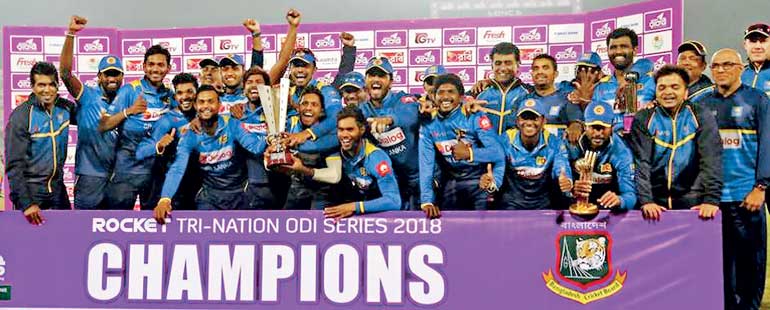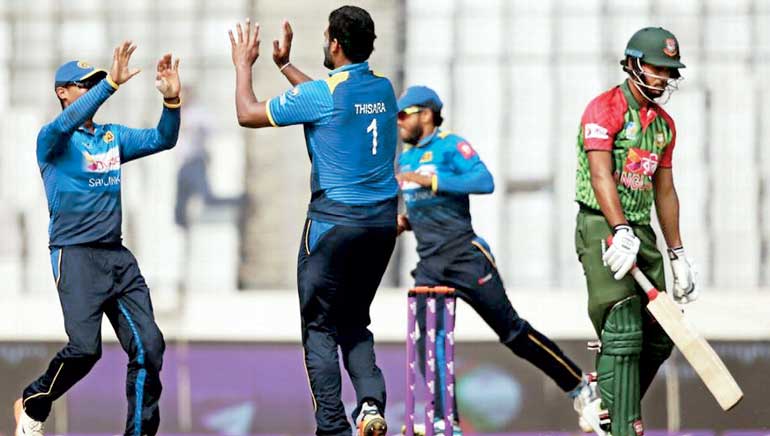Tuesday Mar 04, 2025
Tuesday Mar 04, 2025
Tuesday, 30 January 2018 00:00 - - {{hitsCtrl.values.hits}}


ESPNCricinfo: The tri-series sprung few surprises apart from Sri Lanka’s late rally to clinch the title. But there were a few things that all three sides could take for the rest of 2018. Here are six takeaways from the tournament:
SRI LANKA
Four specialist bowlers is
the right way
Sri Lanka saw the benefits of having Thisara Perera as their fifth bowler, with him bowling his quota of 10 overs. Apart from Suranga Lakmal, they rotated around the main bowlers a number of times but much of the time they stuck to their plans. Dushmantha Chameera and Nuwan Pradeep used the short ball as well as Perera before Shehan Madushanka took the hat-trick to give a glimpse of his ability.
Surprisingly Sri Lanka looked unsure in the spin department but if Akila Dananjaya can bowl like he did in the back end of the tri-series, they can always rotate between the legspin of Wanindu Hasaranga and Lakshan Sandakan’s chinaman.
Batting needs more work
Upul Tharanga and Dinesh Chandimal showed some consistency with the bat but the rest of the Sri Lanka line-up struggled during the tri-series. It got to a point where Thisara Perera’s late runs were a necessity instead of a luxury. The biggest disappointments were certainly Kusal Mendis and Asela Gunaratne. The latter had an especially bad series scoring just 35 runs in four innings.
BANGLADESH
Bowling finds its rhythm
There was much encouragement seeing how Rubel Hossain and Mustafizur Rahman bowled in the middle to late overs. There was nothing new in their bowling apart from being consistent, which is the way to go. Rubel finished the tournament with nine wickets while Mustafizur gave away runs at only 3.24 per over. Sunzmaul Islam did well as the second specialist spinner while Mashrafe Mortaza and Shakib Al Hasan provided the usual control.
The search for a settled line
up goes on
Quite like Sri Lanka, Bangladesh’s batting line-up have a number of questions that need to be addressed. It is true that Shakib Al Hasan could have already established himself as the regular No. 3, but Anamul Haque didn’t give a good audition as Tamim Iqbal’s opening partner. It is likely that Bangladesh will move back to Soumya Sarkar or Imrul Kayes as the other opener.
Serious doubts still hover over Sabbir Rahman and Nasir Hossain, though the bigger concern in this regard is the selectors’ reluctance to find replacements for these two batsmen who, notwithstanding their abilities, have lacked temperament and application for a quite a while now.
ZIMBABWE
Have the ability to punch above their weight
Even after returning to ODIs after seven months, Zimbabwe didn’t take too long to beat Sri Lanka, a higher-ranked side. It might be that the sight of Sri Lanka, the side they beat 3-2 in July last year, worked in their favour but their outing was still very positive.
If Zimbabwe’s batting comes together, particularly if Hamilton Masakadza and Solomon Mire can provide them the fast start in the first 10 overs, then it would invariably encourage their middle-order to press on for a bigger score.
Need to stay in the game longer
Both with bat and ball, it seems Zimbabwe has to stay in the contest for much longer. It isn’t that they give up easily but once they lose early wickets, they find it hard to regain their rhythm. When they lost early wickets against Bangladesh in both games, there was no coming back – a flaw that was apparent very early on.
With the ball in hand, too, they have to find out ways to remove big-hitters They’re a sharp fielding side, so much of this would depend on the bowlers’ depth in skills.
Discover Kapruka, the leading online shopping platform in Sri Lanka, where you can conveniently send Gifts and Flowers to your loved ones for any event including Valentine ’s Day. Explore a wide range of popular Shopping Categories on Kapruka, including Toys, Groceries, Electronics, Birthday Cakes, Fruits, Chocolates, Flower Bouquets, Clothing, Watches, Lingerie, Gift Sets and Jewellery. Also if you’re interested in selling with Kapruka, Partner Central by Kapruka is the best solution to start with. Moreover, through Kapruka Global Shop, you can also enjoy the convenience of purchasing products from renowned platforms like Amazon and eBay and have them delivered to Sri Lanka.
Discover Kapruka, the leading online shopping platform in Sri Lanka, where you can conveniently send Gifts and Flowers to your loved ones for any event including Valentine ’s Day. Explore a wide range of popular Shopping Categories on Kapruka, including Toys, Groceries, Electronics, Birthday Cakes, Fruits, Chocolates, Flower Bouquets, Clothing, Watches, Lingerie, Gift Sets and Jewellery. Also if you’re interested in selling with Kapruka, Partner Central by Kapruka is the best solution to start with. Moreover, through Kapruka Global Shop, you can also enjoy the convenience of purchasing products from renowned platforms like Amazon and eBay and have them delivered to Sri Lanka.